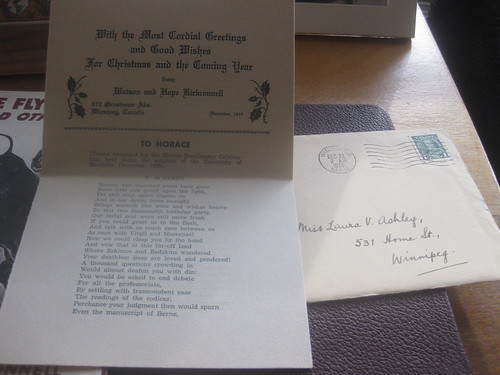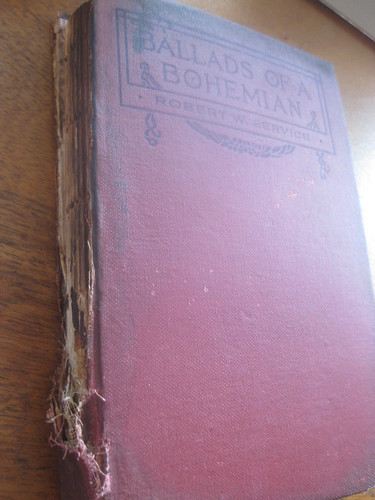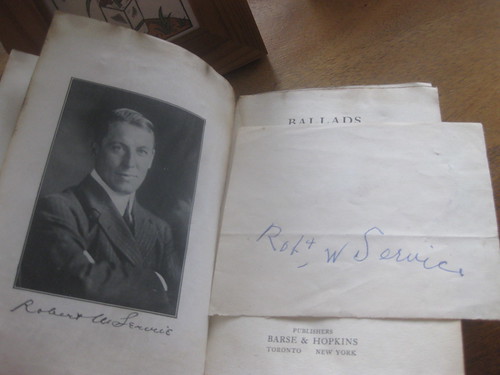April 18, 2011
Objects Found in Books
One of my favourite bookish news stories from the last month is this one in which a typed letter from Robertson Davies to New Canadian Library co-founder Malcolm Ross was found in the pages of a book bought at a Halifax Salvation Army shop for $1. This kind of thing actually happens all the time, though perhaps not so often with such bright lights of Canadian literary history. From as far back as books have been produced in codex-form, people have been putting flattish things in between the pages and have forgetting them there. One of the great pleasures of buying second-hand books is finding them again.
Sometimes this kind of ephemera can be quite valuable to collectors and to libraries, a hunger wonderfully novelized by A.S. Byatt in Possession. More often it is simply another layer of history passed down through the object to the new reader. Old bookmarks, receipts, notes and letters; even pressed flowers, locks of hair and ribbons give a used book a unique character that separates it from other copies of the same book. Even this can be of value to a book history scholar (again, beautifully novelized by Geraldine Brooks in her recent People of the Book), but personally I love the way it gives me my own mystery to solve; good for nothing, probably, but telling a story.
 Two great-aunts of mine, both spinster librarians who kept up friendly correspondence with writerly contemporaries of theirs, were great clippers and hoarders. Few books I’ve inherited from them are free from newspaper clippings, letters and photocopied notes from other books. An old biography of Rudyard Kipling contains clipped Kipling poetry from a 1920s newspaper, while my facsimile of John Gerard’s 1633 Herbal has notes on the authors photocopied from the Oxford Dictionary of National Biography.
Two great-aunts of mine, both spinster librarians who kept up friendly correspondence with writerly contemporaries of theirs, were great clippers and hoarders. Few books I’ve inherited from them are free from newspaper clippings, letters and photocopied notes from other books. An old biography of Rudyard Kipling contains clipped Kipling poetry from a 1920s newspaper, while my facsimile of John Gerard’s 1633 Herbal has notes on the authors photocopied from the Oxford Dictionary of National Biography.
One aunt in particular seems to have been a friend of the Western Canadian author Watson Kirkconnel. One of my favourite ephemeral findings is a Christmas card, sent in 1935, from Kirkconnel and his wife featuring a poem, “To Horace”, otherwise unpublished. Though Kirkconnel is utterly unknown and out of print today, the addition of this cheerful little relic of the past makes this book (a limited edition copy of his Flying Bull and Other Stories) one of my favourites. Kirkconnel has posthumously become an imaginary family friend, part of my own past. Other letters and clippings from Kirkconnel adorn other books in my library: I like to invent and exaggerate the dimensions of my aunt’s relationship with the once-great author. The artifacts give me that right, I think.
 Once when I was very young I snuck into a broken-down house known to me in order to “liberate” a very musty and dilapidated old tome I saw there. I imagined that, being an old broken-down house, all printed materials found within must necessarily be mysterious, valuable, and possibly occult. I was both very wrong and very right. The book, Robert Service’s Ballads of a Bohemian, is utterly worthless because of the condition it is in – torn, moldy, and even slightly burnt-up. On the other hand, it appears to contain a slip of paper bearing Service’s signature. The book is not signed directly, but the name is written on a separate slip found facing the portrait of the author. Is it really the author’s signature? I have no idea. It is not a clean and tidy signature, and looks instead to have been made by someone very advanced in years, or in deteriorating health. That said, that nearly rules out its being a copy or forgery. Any attempt to mislead would surely be closer to the “official” thing. But why else would it be there? This is my bookish mystery. The myth associated with my finding and retrieving this book certainly sounds better if the tale ends with its being a signed copy. Well, it’s my unique relic so, again, I reserve the right to tell the story. It’s signed, my own treasure.
Once when I was very young I snuck into a broken-down house known to me in order to “liberate” a very musty and dilapidated old tome I saw there. I imagined that, being an old broken-down house, all printed materials found within must necessarily be mysterious, valuable, and possibly occult. I was both very wrong and very right. The book, Robert Service’s Ballads of a Bohemian, is utterly worthless because of the condition it is in – torn, moldy, and even slightly burnt-up. On the other hand, it appears to contain a slip of paper bearing Service’s signature. The book is not signed directly, but the name is written on a separate slip found facing the portrait of the author. Is it really the author’s signature? I have no idea. It is not a clean and tidy signature, and looks instead to have been made by someone very advanced in years, or in deteriorating health. That said, that nearly rules out its being a copy or forgery. Any attempt to mislead would surely be closer to the “official” thing. But why else would it be there? This is my bookish mystery. The myth associated with my finding and retrieving this book certainly sounds better if the tale ends with its being a signed copy. Well, it’s my unique relic so, again, I reserve the right to tell the story. It’s signed, my own treasure. 
To beat that poor old horse, it would be a real shame if the digital future inadvertently limited or destroyed the preservation of ephemera. Casual insertion of things into day-to-day books has brought a wealth of everyday artifacts to us. It goes without saying that nothing can be inserted into an ebook, but moreover, it’s more rare for things to be inserted into valuable or collector books. A theoretical future where the remaining printed books are more highly valued as artifacts is one where people are less likely to stick any old thing between the pages. Casually read books are the ones which come to us with the heaviest signs of their history. I was struck while re-reading Frank Herbert’s Emperor of Dune by a scene in which a high-tech book is stolen and then, between the pages, a dried flower is found. The discovery is significant to the characters but also oddly anachronistic. Even in the year 13,000 we’re to presume that the book has remained as much a vehicle for material pieces of life as much as of information.
Of course the ephemera itself is disappearing more quickly than the book in any case. Newspapers? Letters? Recipe cards? Relics of past generations moreso than books. But I’ll miss, you know, receipts, bookmarks and flowers. Wouldn’t you?
I’ve got a collection of bookmarks I’ve found in books as well as a Smoky the Bear postcard, though unfortunately never written on. Also receipts, but the ones I like best are, say, train tickets or receipts for the book purchase…something more interesting than a grocery receipt, though that’s interesting sometimes too, but something that tells the items one bought on a certain day. I can’t think of what other delightful things I’ve found, except a few leaves, I think. But it’s definitely one of the joys of second-hand book reading. I love finding meaningful inscriptions, too.
Your story about the Service book is awesome! Reminded me of The Book Thief, one of my very favourites, along with People of the Book. 🙂
Your reply has made me think of even more excellent things I’ve found in my books! Gosh, playbills (one of my aunts bought lots of plays in the 1930s-1950s and would keep the programs from the first-ever performances of those plays in the book – I’m sorry to say I think I sold most of these books to a dealer), tickets, maps… and what other way would things like this make it through the ages if not flattened and pressed in books?
Inscriptions are another great one! I know books tend not to be valuable unless they are signed by the AUTHOR to, preferably, someone else Of Consequence, but sometimes plain old reader write the nicest things in gift books.
I have a book, Cariboo Horses, that Al Purdy inscribed to a certain Kelly, who apparently also had the “wisdom to write this stuff too.” But you’re right, sometimes inscriptions that “normal” people wrote gifting the book to a precious someone are so beautiful, especially the ones dated long ago. I have a few from C’s mom that are inscribed to her, from the ’50s, for doing well on tests, which they name, in school. One was Treasure Island and the other was a Kay Tracey mystery from 1942 (1951). It’s totally falling apart but it smells SO GOOD…
I wonder if I’ve left anything in books…
Those playbills sound cool!
I also enjoy finding things in books that I left in them, long ago when I was a different person (like, for instance, the type that stored a $2 bill in The Robber Bride).
Wait, there was a $2 bill? I don’t remember. I did find a $1 bill under an ugly red carpet we pulled up in our first apt bathroom years ago…
Oh, duh. I just googled the $2 dollar bill. It wasn’t THAT long ago.
By which I meant, I shouldn’t have forgotten it!
I was going to say; I was in grade 10 or 11 when the Toonie arrived – which wasn’t THAT long ago, was it????